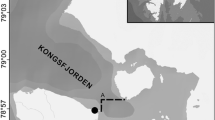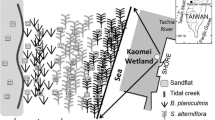Abstract.
A series of 10 samples from sediment in and adjacent to a shallow coastal iceberg scour at Signy Island, Antarctica, were taken by hand coring from 17 December 1993 until 23 August 1994. Scouring by the iceberg led to more than a 95% decrease in meiofaunal abundance and to a certain degree of reduction in diversity. Nematodes were always the most dominant group of meiofauna. The return of major meiofauna groups to control levels was accomplished in 30 days, although a decrease in abundance on the 50th day made interpretation difficult. The pioneering meiofaunal colonisers were copepods and ostracods, followed by nematodes. Microlaimus sp.1 was dominant among the nematodes throughout the whole period. Epistratum feeders and non-selective deposit feeders were highly dominant over selective deposit feeders and predators/omnivores. The Maturity Index, a measure for stress within nematode communities, was relatively low at all times and in controls, which indicates that r-strategists prevail in this community. In spite of the catastrophic destruction, nematode community structure was not affected by the iceberg impact, and there was no evidence of succession during recovery. This suggests that the nematode community in the shallow subtidal coast at Signy Island is well adapted to ice disturbance.
Similar content being viewed by others
Author information
Authors and Affiliations
Additional information
Electronic Publication
Rights and permissions
About this article
Cite this article
Lee, H., Vanhove, S., Peck, L.S. et al. Recolonisation of meiofauna after catastrophic iceberg scouring in shallow Antarctic sediments. Polar Biol 24, 918–925 (2001). https://doi.org/10.1007/s003000100300
Accepted:
Issue Date:
DOI: https://doi.org/10.1007/s003000100300




